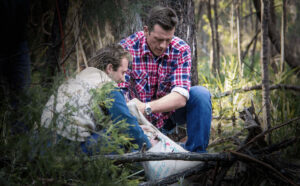
The koala has been listed as ‘Endangered’ in New South Wales, Queensland, and the Australian Capital Territory in 2022. This change in conservation status was in response to the koala facing a very high risk of extinction in the near future (EPBC Act 1999). This is a result of environmental threats, vehicle strikes, predation and disease (OEH NSW). Chlamydia pecorum causes the disease chlamydiosis, the most significant infectious agent impacting free ranging koalas, and is the leading cause of koalas being admitted to hospitals [1]. Chlamydiosis in koalas is spread venereally and causes inflammation of the urogenital tract, resulting in infertility in female koalas and reduced fertility in males, and therefore can be associated with population decline [3-7, 4, 9, 10]. Urinary tract disease can be evident clinically as inflammation of external genitalia and urine staining of the perineal region, colloquially known as a “wet bottom”[8], but koalas affected by chlamydiosis do not always show clinical signs. Chlamydiosis can also cause disease of the eye, which can vary from being asymptomatic, to showing signs of inflammation, to progression to severe disease and blindness[2].
Chlamydiosis is endemic in most Australian mainland populations, however, work over a long period of time by Dr Rob Close, Professor David Phalen and others in collaboration with the local community, has established that the Campbelltown koala population appears to be free of chlamydiosis. The absence of chlamydiosis is thought to be part of the reason for the success and expansion of this population over recent years. Previous work carried out by the Koala Health Hub, local councils and NSW Department of Planning and Environment, in collaboration with local communities, has established that adjacent koala populations between Appin and Robertson have an estimated prevalence of chlamydial infection of approximately 25%, increasing to the south of the zone. Therefore, the risk of transmission of chlamydiosis from neighbouring koala populations to the Campbelltown koalas is now recognised as a potential threat. Health impacts of chlamydiosis could be devastating for the Campbelltown koala population because these animals have never been in contact with the disease.
Vaccination may offer a potential solution. Vaccines against chlamydiosis in koalas, developed by Professor Peter Timms team at University of Sunshine Coast, have been trialled for safety and efficacy in captive healthy koalas, and hospitalised and free ranging koalas affected by chlamydia over the last 12 years. No adverse effects from vaccination have been observed from the 14 published studies [12-26], including no body temperature changes, no inappetence, no swelling, no reactivity at touch, no dehydration and no deaths after administration. Evidence suggests that vaccination is safe and elicits an immune response against chlamydiosis in koalas that lasts for up to 12 months and decreases chlamydial shedding (the potential of transmitting disease) for up to 6 months in koalas in SE Queensland [12-26].
There is now the need to trial vaccination efficacy in wild populations of koalas with and without chlamydiosis over a longer period of time, to assess the potential use of vaccination against this disease as a management tool to protect naïve populations, like the Campbelltown koala population, from emerging disease.
We have designed a program of vaccination in koala populations extending from the Campbelltown region down to the Robertson region, that will allow us to assess the utility of the vaccine as an active management tool to prevent incursion of chlamydiosis. When koalas are caught to be recruited to the vaccination program they are examined by a veterinarian. The vaccine we use has been specifically developed for koalas and has been determined safe to use in both healthy and diseased koalas [12-26]. Our program involves vaccination of koalas in three broad zones: 1. the Campbelltown zone (no disease); 2. an interface zone surrounding Appin (where koalas from the other zones may come in contact), and 3. a southern zone extending into the Southern Highlands (disease present). By recruiting koalas in these three areas, we hope to assess the efficacy of the vaccine in koalas naturally exposed to different levels of disease and reduce the likelihood of chlamydiosis spreading up to Campbelltown from the Southern Highlands. In order to monitor the health of the vaccinated koalas over time, we use small (~30g) radio collars fitted on koalas by a veterinarian. These will allow us to gather welfare and health information on the koalas taking part in the vaccination program over the next 12 months to document their responses to the vaccine.
The work is supported by the Cumberland Plain Conservation Plan and The NSW Koala Strategy and has been approved by The University of Sydney Animal Ethics Committee (AEC Permit #2019/1547) and the New South Wales National Parks and Wildlife Service (NPWS)
(Scientific Permit #SL102331).
References
- Lunney, D., et al., An analysis of the long-term trends in the records of Friends of the Koala in north-east New South Wales: I. Cause and fate of koalas admitted for rehabilitation (1989–2020). Pacific Conservation Biology, 2022.
- Burach, F., et al., Chlamydiaceae and Chlamydia-like organisms in the koala (Phascolarctos cinereus)–organ distribution and histopathological findings. Vet Microbiol, 2014. 172(1-2): p. 230-40.
- Palmieri, C., et al., Chlamydia pecorum Infection in the Male Reproductive System of Koalas ( Phascolarctos cinereus). Vet Pathol, 2019. 56(2): p. 300-306.
- Higgins, D.P., S. Hemsley, and P.J. Canfield, Immuno-histochemical demonstration of the role of chlamydiaceae in renal, uterine and Salpingeal disease of the koala, and demonstration of chlamydiaceae in novel sites. J Comp Pathol, 2005. 133(2-3): p. 164-74.
- Hulse, L., et al., The effect of Chlamydia infection on koala (Phascolarctos cinereus) semen quality. Theriogenology, 2021. 167: p. 99-110.
- Johnston, S.D., et al., Orchitis and Epididymitis in Koalas (Phascolarctos cinereus) Infected With Chlamydia pecorum. Vet Pathol, 2015. 52(6): p. 1254-7.
- Hemsley, S.C., P. , Histopathological and Immunohistochemical Investigation of Naturally Occurring Chlamydial Conjunctivitis and Urogenital Inflammation in Koalas (Phascolarctos cinereus). Journal of Comparative Pathology 1997. 116: p. 273-290.
- Griffith, J.E., STUDIES INTO THE DIAGNOSIS, TREATMENT AND MANAGEMENT OF CHLAMYDIOSIS IN KOALAS, in Faculty of Veterinary science 2010, The Unviersity of Sydney
- Pagliarani, S., et al., Chlamydiosis and cystic dilatation of the ovarian bursa in the female koala (Phascolarctos cinereus): Novel insights into the pathogenesis and mechanisms of formation. Theriogenology, 2022. 189: p. 280-289.
- Hulse, L., et al., Investigation of pathology associated with Chlamydia pecorum infection in the male reproductive tract, and the effect on spermatogenesis and semen quality in the koala (Phascolarctos cinereus). Theriogenology, 2022. 180: p. 30-39.
- Booth, R. and S. Nyari, Clinical comparison of five anti-chlamydial antibiotics in koalas (Phascolarctos cinereus). PLoS One, 2020. 15(7): p. e0236758.
- Carey, A.J., et al., A multi-subunit chlamydial vaccine induces antibody and cell-mediated immunity in immunized koalas (Phascolarctos cinereus): comparison of three different adjuvants. Am J Reprod Immunol, 2010. 63(2): p. 161-72.
- Desclozeaux, M., et al., Immunization of a wild koala population with a recombinant Chlamydia pecorum Major Outer Membrane Protein (MOMP) or Polymorphic Membrane Protein (PMP) based vaccine: New insights into immune response, protection and clearance. PLoS One, 2017. 12(6): p. e0178786.
- Khan, S.A., et al., Antibody and Cytokine Responses of Koalas (Phascolarctos cinereus) Vaccinated with Recombinant Chlamydial Major Outer Membrane Protein (MOMP) with Two Different Adjuvants. PLoS One, 2016. 11(5): p. e0156094.
- Khan, S.A., et al., Humoral immune responses in koalas (Phascolarctos cinereus) either naturally infected with Chlamydia pecorum or following administration of a recombinant chlamydial major outer membrane protein vaccine. Vaccine, 2016. 34(6): p. 775-82.
- Khan, S.A., et al., Vaccination of koalas (Phascolarctos cinereus) with a recombinant chlamydial major outer membrane protein adjuvanted with poly I:C, a host defense peptide and polyphosphazine, elicits strong and long lasting cellular and humoral immune responses. Vaccine, 2014. 32(44): p. 5781-6.
- Kollipara, A., et al., Vaccination of healthy and diseased koalas (Phascolarctos cinereus) with a Chlamydia pecorum multi-subunit vaccine: evaluation of immunity and pathology. Vaccine, 2012. 30(10): p. 1875-85.
- Kollipara, A., et al., Vaccination of koalas with a recombinant Chlamydia pecorum major outer membrane protein induces antibodies of different specificity compared to those following a natural live infection. PLoS One, 2013. 8(9): p. e74808.
- Kollipara, A., et al., Antigenic specificity of a monovalent versus polyvalent MOMP based Chlamydia pecorum vaccine in koalas (Phascolarctos cinereus). Vaccine, 2013. 31(8): p. 1217-23.
- Nyari, S., et al., Therapeutic effect of a Chlamydia pecorum recombinant major outer membrane protein vaccine on ocular disease in koalas (Phascolarctos cinereus). PLoS One, 2019. 14(1): p. e0210245.
- Nyari, S., et al., Vaccination of koalas (Phascolarctos cinereus) against Chlamydia pecorum using synthetic peptides derived from the major outer membrane protein. PLoS One, 2018. 13(6): p. e0200112.
- Phillips, S., et al., Vaccination of koalas during antibiotic treatment for Chlamydia-induced cystitis induces an improved antibody response to Chlamydia pecorum. Sci Rep, 2020. 10(1): p. 10152.
- Waugh, C., et al., Treatment of Chlamydia-associated ocular disease via a recombinant protein based vaccine in the koala (Phascolarctos cinereus). Biologicals, 2016. 44(6): p. 588-590.
- Waugh, C., et al., A Prototype Recombinant-Protein Based Chlamydia pecorum Vaccine Results in Reduced Chlamydial Burden and Less Clinical Disease in Free-Ranging Koalas (Phascolarctos cinereus). PLoS One, 2016. 11(1): p. e0146934.
- Waugh, C.A. and P. Timms, A proposed roadmap for the control of infections in wildlife using Chlamydia vaccine development in koalas Phascolarctos cinereus as a template. Wildlife Biology, 2020. 2020(1).
- Waugh, C.A., et al., Comparison of subcutaneous versus intranasal immunization of male koalas (Phascolarctos cinereus) for induction of mucosal and systemic immunity against Chlamydia pecorum. Vaccine, 2015. 33(7): p. 855-60.

